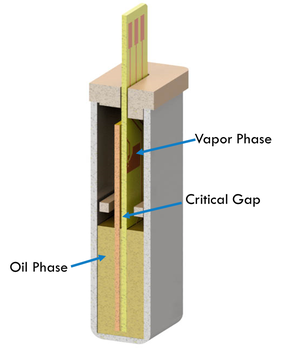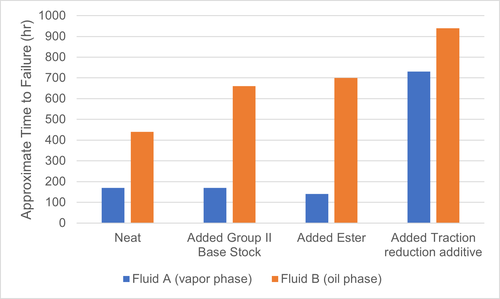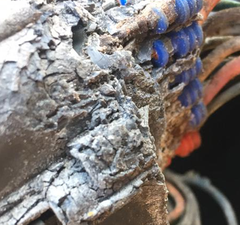Electric Driveline Fluid Testing Update June 2023
Conductive Deposit Test (CDT)
and Wire Corrosion Test (WCT)
 The automotive lubricant industry has been charged on the buzz around electric
vehicles for the last few years. In the 2021, Savant shared
news about new methods developed specifically to test fluids for
compatibility with electric vehicles and the then-in-progress SAE
document listing these tests. Last fall the awaited SAE J3200_202210
Information Report was published. As expected, it includes a discussion
of the benefits and uses of the Conductive Deposit Test (CDT) and the
Wire Corrosion Test (WCT) that Savant Labs now offers, along with several
other tests. More action regarding these tests is ongoing within
the ASTM D02 Committee. Last December the ASTM D02 Subcommittee 9 on
Oxidation of Lubricants presented plans to complete a full Interlaboratory
Study (ILS) to determine a precision statement for the Conductive Deposit
Test and make it an official ASTM Standard Test Method. The
Subcommittee also presented plans for a pilot study on the Wire Corrosion
Test to determine how many labs will need to participate in an upcoming
full ILS.
The automotive lubricant industry has been charged on the buzz around electric
vehicles for the last few years. In the 2021, Savant shared
news about new methods developed specifically to test fluids for
compatibility with electric vehicles and the then-in-progress SAE
document listing these tests. Last fall the awaited SAE J3200_202210
Information Report was published. As expected, it includes a discussion
of the benefits and uses of the Conductive Deposit Test (CDT) and the
Wire Corrosion Test (WCT) that Savant Labs now offers, along with several
other tests. More action regarding these tests is ongoing within
the ASTM D02 Committee. Last December the ASTM D02 Subcommittee 9 on
Oxidation of Lubricants presented plans to complete a full Interlaboratory
Study (ILS) to determine a precision statement for the Conductive Deposit
Test and make it an official ASTM Standard Test Method. The
Subcommittee also presented plans for a pilot study on the Wire Corrosion
Test to determine how many labs will need to participate in an upcoming
full ILS.
With industry standardization groups showing so much interest in electric
driveline fluid tests, it’s clear that they are important to the
industry. Why are they so important? In the last two years,
many lubricant manufacturers have been developing special-purpose
lubricants to meet the needs of electric vehicles. This follows a
period when axle oils, manual transmission fluids, or ATFs were used to
lubricate the electric vehicle driveline and even to provide cooling to
the electric motor. Corrosion to an electric motor exposed to a lubricant
has been known to cause catastrophic failures [1], [2], [3]. Perhaps the
recent interest in dedicated fluids results from knowledge of such
instances and the needs outlined in SAE J3200_202210. Whether producing a
lubricant tailored to the specific needs of an electric vehicle or
verifying the compatibility of a pre-existing fluid with an EV
application, it has become necessary to use tests that can reveal
critical failures, such as the CDT and WCT.
Conductive
Deposit Test The Conductive
Deposit Test is specifically designed to detect conductive deposits that
could create a short in an electric motor or other critical
circuitry. A printed circuit board with copper traces is used to
stand in for relevant copper-containing electrical components, such as
motor windings, in the electric vehicle. The circuit board is exposed to
the test fluid under controlled temperature with minimal fluid flow and
closed, but not sealed, headspace. This simulates the conditions in
EVs where components are tightly spaced and may not see much fluid
circulation or are exposed to vapors from the lubricant during normal
use. As copper from the circuit is corroded, it can combine with
components of the fluid and stick to the circuit board as deposits.
If these deposits can conduct electricity, a problem occurs when
they bridge the gap between two otherwise unconnected circuit
components. In a real-life application, this could cause unintended
currents to flow between circuit components, quickly overheating the
components, and causing deformation or even welding [3]. In the CDT, the
resistance measured on the test drops to a low value. The speed
with which this happens and the final resistance are used to infer the
suitability of a fluid for the application. Limits are currently
set by each manufacturer, but industry-wide limits may eventually be
established by standardization groups. The test may run for up to
1000 hours to build extra confidence in the long-term operation of the
fluid, but the resistances drop to concerning values in less than 500
hours for fluids with problematic results in the field. In addition, as
the deposits form, the variability of the resistance increases
dramatically due to the intermittent nature of the electrical connection formed
by the deposit. This is measured with the Conductive Deposit Index
(CDI). Either the CDI or the resistance value can be used to
identify a fluid with poor performance in the field. Both the resistance
limit indicating a failure and the Conductive Deposit Index limit
indicating a failure may be adjusted to correspond with particular
applications.
The Conductive
Deposit Test is specifically designed to detect conductive deposits that
could create a short in an electric motor or other critical
circuitry. A printed circuit board with copper traces is used to
stand in for relevant copper-containing electrical components, such as
motor windings, in the electric vehicle. The circuit board is exposed to
the test fluid under controlled temperature with minimal fluid flow and
closed, but not sealed, headspace. This simulates the conditions in
EVs where components are tightly spaced and may not see much fluid
circulation or are exposed to vapors from the lubricant during normal
use. As copper from the circuit is corroded, it can combine with
components of the fluid and stick to the circuit board as deposits.
If these deposits can conduct electricity, a problem occurs when
they bridge the gap between two otherwise unconnected circuit
components. In a real-life application, this could cause unintended
currents to flow between circuit components, quickly overheating the
components, and causing deformation or even welding [3]. In the CDT, the
resistance measured on the test drops to a low value. The speed
with which this happens and the final resistance are used to infer the
suitability of a fluid for the application. Limits are currently
set by each manufacturer, but industry-wide limits may eventually be
established by standardization groups. The test may run for up to
1000 hours to build extra confidence in the long-term operation of the
fluid, but the resistances drop to concerning values in less than 500
hours for fluids with problematic results in the field. In addition, as
the deposits form, the variability of the resistance increases
dramatically due to the intermittent nature of the electrical connection formed
by the deposit. This is measured with the Conductive Deposit Index
(CDI). Either the CDI or the resistance value can be used to
identify a fluid with poor performance in the field. Both the resistance
limit indicating a failure and the Conductive Deposit Index limit
indicating a failure may be adjusted to correspond with particular
applications.
Currently, Savant has multiple customers routinely using the CDT to assess EV fluids. In addition, research efforts proceed. In a paper recently presented at the OilDoc conference, Greg Miiller of Savant Group compared failure times for two fluids with their failure times once diluted with group II base stock, an ester, and a traction reduction additive. Fluid A was considered poor performing in the vapor phase while Fluid B was considered to have poor performance in the oil phase. As can be seen in the graph below, addition of the tracking fluid greatly reduced the likelihood of conductive deposit formation for each fluid within those fluids problematic deposit forming region and outperformed the other diluents tested. Future studies are currently in the developmental stage to examine the effects of mixed lubricant systems for EV applications.

Figure 1. Summary
of dilution results for Fluid A and Fluid B.
Wire
Corrosion Test  While the CDT
assesses the tendency of a fluid to create conductive deposits that can
short a circuit, the wire corrosion test quantifies the tendency of a
fluid to corrode copper. Traditional copper corrosion tests like
ASTM D130 and adaptations based on it tend to be subjective and
qualitative. The advantage of the wire corrosion test is that the
corrosion rate can actually be determined in a given sample. A thin
wire is exposed to an oil and its vapor with a separate circuit for each
phase at a controlled temperature for 72 hours. In the case of the WCT,
the wires are spaced sufficiently far apart that no deposits would be
able to bridge the gap. Furthermore, the wires are suspended so there is
no substrate on which deposits can form. As the copper is corroded the
resistance of the circuit increases. Based on the known initial
diameter and resistance of the wire, the diameter can be calculated at
any time during the test based on the resistance, and the actual rate of
corrosion can be determined. Furthermore, this test can easily be
conducted at temperatures from 80 °C to 150 °C, allowing the temperature
dependence of corrosion rates to be established for different fluids in
both the oil and vapor phases [1]. The developers of this test found that
temperature dependence varies significantly by fluid and that the hottest
temperatures may not always be the most severe, particularly in the vapor
phase [3]. These results underscore the importance of testing
changes in formulation and testing across the full range of temperatures
anticipated in the application. Savant Labs has been offering the WCT
since 2021, and multiple customers have made use of the ability to test
at several temperatures in order to fully characterize the copper
corrosion effects of various fluids. In addition, the duration of the
test can be extended to examine the corrosion rates in even very
high-performing fluids.
While the CDT
assesses the tendency of a fluid to create conductive deposits that can
short a circuit, the wire corrosion test quantifies the tendency of a
fluid to corrode copper. Traditional copper corrosion tests like
ASTM D130 and adaptations based on it tend to be subjective and
qualitative. The advantage of the wire corrosion test is that the
corrosion rate can actually be determined in a given sample. A thin
wire is exposed to an oil and its vapor with a separate circuit for each
phase at a controlled temperature for 72 hours. In the case of the WCT,
the wires are spaced sufficiently far apart that no deposits would be
able to bridge the gap. Furthermore, the wires are suspended so there is
no substrate on which deposits can form. As the copper is corroded the
resistance of the circuit increases. Based on the known initial
diameter and resistance of the wire, the diameter can be calculated at
any time during the test based on the resistance, and the actual rate of
corrosion can be determined. Furthermore, this test can easily be
conducted at temperatures from 80 °C to 150 °C, allowing the temperature
dependence of corrosion rates to be established for different fluids in
both the oil and vapor phases [1]. The developers of this test found that
temperature dependence varies significantly by fluid and that the hottest
temperatures may not always be the most severe, particularly in the vapor
phase [3]. These results underscore the importance of testing
changes in formulation and testing across the full range of temperatures
anticipated in the application. Savant Labs has been offering the WCT
since 2021, and multiple customers have made use of the ability to test
at several temperatures in order to fully characterize the copper
corrosion effects of various fluids. In addition, the duration of the
test can be extended to examine the corrosion rates in even very
high-performing fluids.
Learning
More About EV Driveline Fluid Testing
Perhaps the best way to learn more about how you might use the Conductive
Deposit Test and the Wire Corrosion Test to electrify the development of your EV
fluids is to contact us for a conversation about how Savant Labs can
adapt these tests to your specific needs.
References
[1] Miiller, Gregory; VanBergen, William; Kurchan, Alexei; Gillespie, David;
Mueller, Gunther; Pelz, Rico; Newcomb, Timothy; Hunt, Gregory, (2023, May
9 -11). Research and Development Utilizing the Conductive Layer Deposits
and Wire Corrosion Bench Test Technology for Electric Vehicle
Drivetrains, OilDoc Conference 2023, Rosenheim, Germany.
[2] Van Rensselar, Jeanna. (2022, November). “Rapidly expanding electric
vehicle market spurs lubricant development urgency.” Tribology & Lubrication
Technology, 78 (11), pp. 34-40.
[3] SAE 2020-01-0561 “Understanding Vapor and Solution Phase Corrosion of
Lubricants Used in Electrified Transmissions” Hunt, Gregory and
Prengaman, Christopher.
